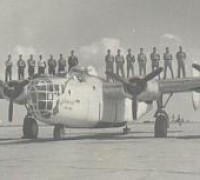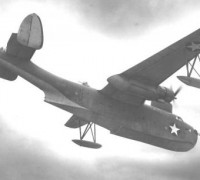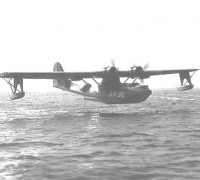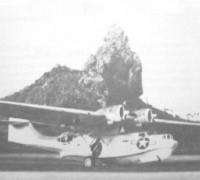U.S. NAVY VP SQUADRONS IN BRAZIL - VP SQUADRONS IN BRAZIL
20)VPB 94 - E
Cont.
On 10 April 1944, The squadron reached an all time high in detached duty at one time. Four Planes were on Fernando Noronha, two were operating under Comblimpron 41 at Sao Luiz, three crews were in Norfolk, Virginia to ferry new planes to Brazil, one plane was supplementing the Fleet Air Wing Sixteen cargo service from Recife, one pilot was assisting the Wing Utility squadron in PBY qualifications, one pilot was enroute to Africa as navigator for a Free French PBY, one officer was attending the Asdevlant ground school at Quonset Point, Rhode Island, one officer was in Rio on leave and the administrative command (what was left of it) was at Belem.
Such squadron diversification led to the 94 slogan and shingle which hangs outside the Commanding Officer's office - "Casa do VP-94 - Branch Ofices in all principal cities." In April 1, 1944 squadron administration was transferred to Maceio for a short while. Maceio offered the most undesirable flying conditions of any the squadron had to face with the exception of Zandery. But in other respects it proved to be a desirable base. Civilization had come to such out of the way places by this time...and the barracks, the food and the recreation facilities were above average. The outdoor theatre was very popular, even when it rained.
Ipitanga, the air station located near Bahia, Brazil was the final stop for the administrative command of the squadron while it was based in South Amerca. It has been popular with everyone attached to the squadron for a number of reasons. The climate has been excellent and flying conditions just as good. The barracks accommodations have been comfortable but slightly overcrowded and the food has always been plentiful.
Recreation has been centered almost entirely in athletics such as volleyball, basketball, softball, baseball, tennis, handball, and swimming. When a detachment was ordered to Santa Cruz, frequent ferry trips were necessary. The resulting liberties in Rio made Ipitanga more popular than ever. In July of this year, a detachment was ordered to Santa Cruz to participated in a submarine hunt with detachments of two PBM squadrons (VP-203 and VP-211). This proved to be the last submarine activity the squadron has been engaged in as the area has been free of enemy U-boats since that time.
A non-operational detachment at Santa Cruz was established in August of 1944 as the USBATU (United States Brazilian Aviation Training Unit) under Lt. Comdr. Richard J. Craig, USN. Five Aircraft of the squadron were assigned to this work. The Squadron had had previous experience working with Brazilian pilots and crewmen while still stationed at Belem in April 1944. Part of a Brazilian squadron of PBY-5s was located at Belem at the time. VP-94 instituted a program of training, consisting of practical classes for radiomen and anti-submarine bombing practice for pilots.
Under the direction of Lt. Comdr. H.R. Swenson, USNR 77963, a comprehensive training syllabus was drawn up for the Santa Cruz training program and submitted to Fleet Air Wing Sixteen, which had initiated the USBATU.
The program was designed to provide a month's training in the PBY-5As for three separate classes of Brazilian pilots and aircrewmen and suitable maintenance training under the direction of Hedron 16. Upon completion of the first groups training September 15, it was sent to Ipitanga to undergo two months of operational training with the main body of the squadron. The second USBATU class, completed October 15, was moved to Belem, there to undergo operational training for a one month period with VPB-45.
The third USBATU class, completed November 15, was given its operational training by the preceding classes when the entire group was assigned to Galeao, the seaplane base at Rio de Janeiro 15 November. Six aircraft of VPB-94 were assigned to the Brazilian unit at that time, to form the nucleus of the proposed 15 plane Brazilian squadron. Lt. Comdr. Craig remained in operational control until 15 December, when the total of 15 aircraft were formally assigned to the Brazilians.
Six weeks of intensive groundwork was engaged in by the VP-94 officers who were to be assigned to USBATU. Each pilot was placed in a squadron department and assigned lectures to be given to the Brazilians on such topics as navigation, gunnery radio and radar, anti-submarine warfare, et c. Lecture notes were mimeographed in Portuguese and the services of an interpreter were made available to aid the few Brazilians who did not understand English.
Flight hours were spent in bounce drills, navigation problems, radio procedure including use of the range and direction finding equipment, and general familiarization with the performance characteristics of the PBY-5A. By this time the first class reported to Ipitanga and the second class to Belem, the Brazilians were thoroughly familiar with the basic syllabus set up by the squadron. At Ipitanga, they commenced two months of intensive operational training, which included all kinds of day and night flying, single engine operation, anti-submarine bombing, escort of convoys and anti-submarine sweeps.
The crewmen were assigned to specific planes, to work with the regular American crews. Pilots were given a series of lectures on anti-submarine, recognition of ships and planes and technical aspects of the PBY5A and its equipment. Toward the completion of the training at Ipitanga, Brazilian crews and pilots were flying all of the squadron's operational missions, with a Navy PPC as passenger and observer.
A constant endeavor was made by the squadron to make the Brazilian personnel feel that it was part of the organization. A Brazilian aspirante acted as Assistant Squadron Duty Officer each day and saw to it that the flight schedule and other pertinent information reached all Brazilian pilots and crew members. Flight, Engineering, Gunnery, Personnel, Operations, Navigation, Communications, Radio-Radar, and Training. At the same time, Brazilian ground officers and maintenance men were receiving similar training from the Ipitanga Hedron 16 detachment.
Evidence of the success of the program came in November, when the squadron commanding officer was awarded the Commendation Ribbon by Vice Admiral Jonas H. Ingram, Commander Fourth Fleet. Pilot training in VP94 has been continuous since the squadron's inception. Depending upon operational hours to be flown, the amount of it has varied considerably from month to month and from one location to another. In its first days at Norfolk, the majority of hours in the air were spent in checking out Patrol Plane Commanders, 1st and 2nd pilots.
The goal aimed for was complete familiarization with the PBY5A. Thus operational training was held to a minimum. The detachment at Cherry Point found itself with so many operational flights to make that training had to be incorporated in each operational mission, whether escort of convoy or anti-submarine sweep. Anti-submarine warfare involving aircraft was far from a science in 1942 and 1943. Depth bombs hydrostatic fused were set at 75 and 125 feet. Very little was known about the submarine, and consequently the best way to attack it.
A start was being made by December 1942 however, for in that month a VP-94 PBY5A was ordered by Comfairwinglant to Dahlgren Virginia for tests of anti-submarine equipment. While the squadron was still at Quonset Point, MAD gear was installed three aircraft and a series of tests made with it . By the time the squadron left the States for South America, however, this equipment had been removed. The Squadron was one of the first to experiment with search lights. They were installed on three aircraft in August of 1942 and used experimentally for a short while.
But the generators could not handle the extra load demand by the powerful lights and the installations were removed before the organization left the States. The importance of practice bombing was realized early in the squadron's history. The difficulty of using miniature bombs led to the development of a miniature bomb rack by an electrician attached to the organization, Alkire, Robert E., EM1c, USN. This rack enabled the pilot to drop one miniature bomb at a time from the tunnel hatch.
The rack was accepted by the Bureau of Ordnance following Alkire's detailed report of the device to the Bureau of Aeronautics and was in common use until the more adaptable wing rack was developed. Alkire's work led to a commendation at Meritorious Mast by the Squadron Commander, to an appointment as a Chief Petty Officer, and eventually to his commission as Ensign.
The first training report made officially by VP-94 covered the period 3 March 1942 (date of commissioning) to 15 August 1942. Figures taken from it give an overall picture of the type but not the intensity of training that has been characteristic since the squadron commenced.
Cont.



